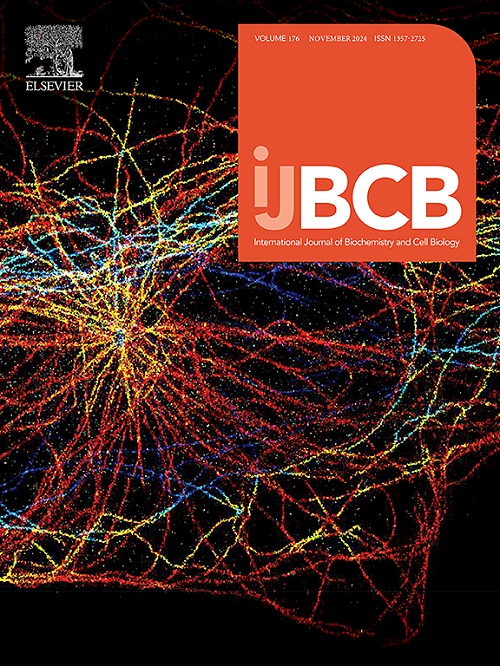Paeoniflorin regulates microglia-astrocyte crosstalk, inhibits inflammatory response, and alleviates neuropathic pain through HSP90AA1/HMGB1 signaling pathway
IF 3.4
3区 生物学
Q2 BIOCHEMISTRY & MOLECULAR BIOLOGY
International Journal of Biochemistry & Cell Biology
Pub Date : 2024-10-11
DOI:10.1016/j.biocel.2024.106675
引用次数: 0
Abstract
Given the unclear, complex pathogenesis of neuropathic pain and the potential of paeoniflorin in relieving neuropathic pain, this study aimed to further clarify the therapeutic effect of paeoniflorin on neuropathic pain and to preliminarily explore the possible protective mechanisms of paeoniflorin. Chronic constrictive injury-induced Sprague Dawley rats and lipopolysaccharide-induced BV-2 cells were used for in vivo and in vitro experiments, respectively. The exosome uptake assay of mouse astrocytes (PKH-67 fluorescent labeling) and the mechanical nociceptive assay (the von Frey fibrous filaments) were performed. The effects of paeoniflorin and its downstream mechanisms on microglial and astrocyte activation, inflammation-associated proteins and exosome marker were determined. Paeoniflorin alleviated mechanical abnormal pain, decreased levels of ionized calcium binding adapter molecule-1 (Iba-1), glial fibrillary acidic protein, Heat Shock Protein 90 Alpha Family Class A Member 1 (HSP90AA1, inflammatory factor) and High Mobility Group Box 1 (HMGB1, inflammation-related protein), and inhibited neuronal apoptosis in chronic constrictive injury rats or lipopolysaccharide-induced BV-2 cells. However, these effects were offset by HSP90AA1 overexpression in lipopolysaccharide-induced BV-2 cells. Exosomes of BV-2 cells could be absorbed by mouse astrocytes. In addition, HSP90AA1 overexpression reversed the effects of paeoniflorin on HMGB1 expression and inflammatory factors and proteins in mouse astrocytes co-cultured with exosome. Collectively, paeoniflorin alleviates neuropathic pain and inhibits inflammatory responses in chronic constrictive injury by modulating microglia-astrocyte crosstalk through HSP90AA1/HMGB1 pathways, which further evidences the potential of paeoniflorin in the treatment of neuropathic pain.
芍药苷可通过HSP90AA1/HMGB1信号通路调节小胶质细胞与星形胶质细胞之间的串扰、抑制炎症反应并缓解神经性疼痛。
鉴于神经病理性疼痛的发病机制不明确且复杂,以及芍药苷在缓解神经病理性疼痛方面的潜力,本研究旨在进一步阐明芍药苷对神经病理性疼痛的治疗作用,并初步探讨芍药苷可能的保护机制。实验分别采用慢性收缩性损伤诱导的 Sprague Dawley 大鼠和脂多糖诱导的 BV-2 细胞进行体内和体外实验。进行了小鼠星形胶质细胞外泌体摄取试验(PKH-67荧光标记)和机械痛觉试验(von Frey纤维丝)。测定了芍药苷及其下游机制对小胶质细胞和星形胶质细胞活化、炎症相关蛋白和外泌体标记物的影响。芍药苷减轻了机械性异常疼痛,降低了离子化钙结合适配分子-1(Iba-1)、神经胶质纤维酸性蛋白、热休克蛋白 90 Alpha 家族 A 类成员 1(HSP90AA1,炎症因子)和高迁移率组框 1(HMGB1,炎症相关蛋白)的水平,并抑制了慢性收缩性损伤大鼠或脂多糖诱导的 BV-2 细胞中神经元的凋亡。然而,在脂多糖诱导的 BV-2 细胞中过表达 HSP90AA1 会抵消这些作用。BV-2细胞的外泌体可被小鼠星形胶质细胞吸收。此外,HSP90AA1的过表达逆转了芍药苷对与外泌体共培养的小鼠星形胶质细胞中HMGB1表达以及炎症因子和蛋白的影响。总之,芍药苷通过HSP90AA1/HMGB1途径调节小胶质细胞-星形胶质细胞的串联,从而缓解神经病理性疼痛并抑制慢性收缩性损伤的炎症反应,这进一步证明了芍药苷在治疗神经病理性疼痛方面的潜力。
本文章由计算机程序翻译,如有差异,请以英文原文为准。
求助全文
约1分钟内获得全文
求助全文
来源期刊
CiteScore
8.10
自引率
0.00%
发文量
124
审稿时长
19 days
期刊介绍:
IJBCB publishes original research articles, invited reviews and in-focus articles in all areas of cell and molecular biology and biomedical research.
Topics of interest include, but are not limited to:
-Mechanistic studies of cells, cell organelles, sub-cellular molecular pathways and metabolism
-Novel insights into disease pathogenesis
-Nanotechnology with implication to biological and medical processes
-Genomics and bioinformatics

 求助内容:
求助内容: 应助结果提醒方式:
应助结果提醒方式:


